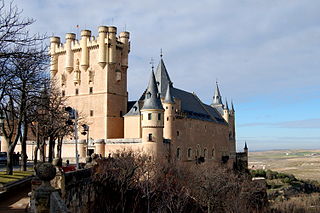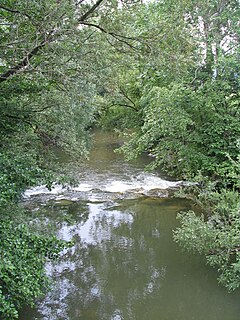
Bodovlje is a village in the Municipality of Škofja Loka in the Upper Carniola region of Slovenia.

Jablje Castle, also known as Jable Castle, Habah Castle, or Habach Castle, is a castle above the settlement of Loka pri Mengšu, Slovenia. It is located on the western edge of the Mengeš Plain.
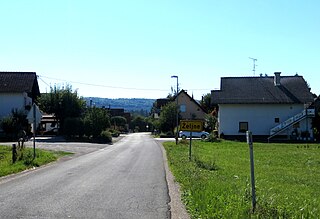
Željne is a village northeast of the town of Kočevje in southern Slovenia. The area is part of the traditional region of Lower Carniola and is now included in the Southeast Slovenia Statistical Region.

Vrbljene is a village south of Tomišelj in the Municipality of Ig in central Slovenia. The municipality is part of the traditional region of Inner Carniola and is now included in the Central Slovenia Statistical Region.

Podgrad is a settlement east of the capital Ljubljana in central Slovenia. It belongs to the City Municipality of Ljubljana. It lies on the right bank of the Ljubljanica River at the entrance into the Besnica Valley. The Ljubljanica in turn flows into the Sava immediately northeast of the settlement core. The railway line from Ljubljana to Zidani Most runs through the settlement. The area was part of the traditional region of Lower Carniola and is now included with the rest of the municipality in the Central Slovenia Statistical Region.

Srednje Gameljne lies north of the capital Ljubljana in central Slovenia. It belongs to the City Municipality of Ljubljana. It was part of the traditional region of Upper Carniola and is now included with the rest of the municipality in the Central Slovenia Statistical Region.

Olešče is a settlement in the Municipality of Laško in eastern Slovenia. It lies in the hills east of Laško. The area was traditionally part of the Styria region. It is now included with the rest of the municipality in the Savinja Statistical Region.

Gradec is a remote abandoned settlement in the Municipality of Črnomelj in the White Carniola area of southeastern Slovenia. The area is part of the traditional region of Lower Carniola and is now included in the Southeast Slovenia Statistical Region. Its territory is now part of the village of Rožič Vrh.

Kuhlarji is a village in the Municipality of Kočevje in southern Slovenia. The area is part of the traditional region of Lower Carniola and is now included in the Southeast Slovenia Statistical Region. It no longer has any permanent residents.

Zadvor is a formerly independent settlement in the southeast part of the capital Ljubljana in central Slovenia. It belongs to the City Municipality of Ljubljana. It was part of the traditional region of Lower Carniola and is now included with the rest of the municipality in the Central Slovenia Statistical Region. In addition to the main settlement, Zadvor consists of the hamlets of Križavka to the southeast, near Saint Leonard's Church in Sostro, Žabja Vas to the south below Zadvor Hill, and Cegelnica next to that. In Žabja Vas there are two ponds in pits that were dug for the former brickworks at Cegelnica.

Čirčiče is a former settlement in the Municipality of Kranj in the Upper Carniola region of Slovenia. It now corresponds to the neighborhood of Čirče in Kranj.

Kamnjek is a former settlement in the Municipality of Kranj in the Upper Carniola region of Slovenia. It now a hamlet of the village of Letenice. It lies west of the village center of Letenice, in a small damp valley on a road leading into the east side of the Udin Woods.

Šmarjetna Gora is a former settlement in the Municipality of Kranj in the Upper Carniola region of Slovenia. Šmarjetna Gora was a dispersed settlement on the southern and eastern slopes of Mount Saint Margaret west of the Sava River. It is now part of the city of Kranj.

Gradec is a former settlement in the Municipality of Litija in central Slovenia. It is now part of the town of Litija. Traditionally the area was part of Styria and is now included with the rest of the municipality in the Central Sava Statistical Region.
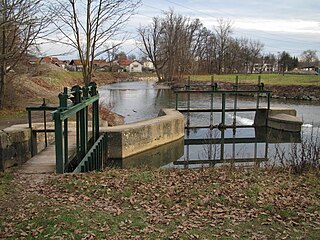
Vrhovci is a formerly independent settlement in the southwest part of the capital Ljubljana in central Slovenia. It was part of the traditional region of Upper Carniola and is now included with the rest of the municipality in the Central Slovenia Statistical Region. It includes the territory of Bokalce Castle.

Stranska Vas is a formerly independent settlement in the northwest part of the town of Grosuplje in central Slovenia. It belongs to the Municipality of Grosuplje. It was part of the traditional region of Lower Carniola and is now included with the rest of the municipality in the Central Slovenia Statistical Region.

Obrije is a formerly independent settlement in the northeast part of the capital Ljubljana in central Slovenia. It was part of the traditional region of Upper Carniola and is now included with the rest of the municipality in the Central Slovenia Statistical Region.

Glinica is a former settlement in central Slovenia in the northwest part of the capital Ljubljana. It belongs to the Dravlje District of the City Municipality of Ljubljana. It was part of the traditional region of Upper Carniola and is now included with the rest of the municipality in the Central Slovenia Statistical Region.

Huje is a former settlement in the Municipality of Kranj in the Upper Carniola region of Slovenia. It now corresponds to the neighborhood of Huje in Kranj. Huje lies on left bank of the Kokra River directly east of the old town center of Kranj, which it is connected to by two bridges.
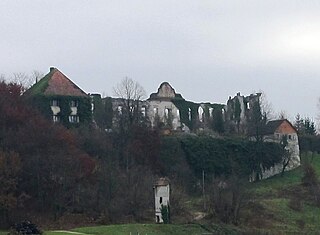
Boštanj is a formerly independent settlement in the southern part of the village of Veliko Mlačevo in central Slovenia. It belongs to the Municipality of Grosuplje. It was part of the traditional region of Lower Carniola and is now included with the rest of the municipality in the Central Slovenia Statistical Region.



